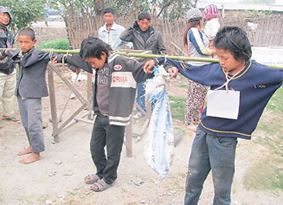 The social media in Nepal was flooded with a photo share which showed three young boys tied to a bamboo pole on 22 February 2014. Three small boys aged 11 to 14 were caught stealing some mushroom packets and noodles in the settlement which lies near Aapgachhichok in Itahari-2, Sunsari district of Nepal. The boys were reportedly punished when the villagers caught them red-handed.
The social media in Nepal was flooded with a photo share which showed three young boys tied to a bamboo pole on 22 February 2014. Three small boys aged 11 to 14 were caught stealing some mushroom packets and noodles in the settlement which lies near Aapgachhichok in Itahari-2, Sunsari district of Nepal. The boys were reportedly punished when the villagers caught them red-handed.
A bamboo pole was placed across their shoulders and their wrists were tied to it.
Their punishment did not stop there. The villagers took Krishna Rai (11), Sanjog Rai (13), and Jit Bahadur Rai (14), under their control and paraded them through the village. The children live in a landless settlement nearby Rajdevi Temple, and are fifth graders at a local school.
The villagers called the police and informed them they had caught some thieves. The police team immediately arrived at the place and released the children from the bamboo. The police then escorted the children to the Area Police Office Itahari. The inhumanity intrinsic to the incident was so stark that even the Nepal police who are notorious for similar acts found it unacceptable.
The villagers claimed to have punished the boys for their repeated habit of stealing in the village. The locals considered that the punishment was required so that they would not repeat those acts in the future. The family of these children is poor and powerless. They live in a landless settlement which is set aside for people who toil all day, barely earning USD 2-3. The parents drive rickshaw for their livelihoods. Basically these families do not have any power to fight.
The parents were not happy at how the children were treated but did not protest. They just took it as punishment for their deeds. The police handed the children to their families on 23 February 2014.
This incident depicts the stark state of affairs in Nepal. There is no rule of law, and no justice system, a reason why the people turn into mobs and take matters into their own hands. The tactic used to punish these children presents a mindset that has internalized violence and hierarchy. Only people who have accepted hierarchy and casteism demonstrate this kind of barbarous attitude. It has been often found that mobs always attack the dispossessed, deprived and the poor. Whenever people catch a pick pocket, they often mercilessly beat him before handing him over to the police.
Instead of thinking what forces these children to steal in the first place and address the structural reasons, the mob simply tortures the children in public which is far worse than anything. In a society that accepts police torture as a means of investigation, this is the least one can expect.
The AHRC is concerned about the physical and psychological torture these children had to face. It might affect their whole future. There is also a risk that they might turn violent in future due to this incident.
As the popular saying goes, ‘A child is like a pot in the hands of a pot-maker, so one can decide how to shape it during the initial years’. This incident might put a stigma on the rest of their lives.
This incident could be taken as an indication of the almost total failure of the state. The AHRC urges the Nepali government to take these issues more seriously. The state must act to stop such public punishments otherwise they will only increase in future and there is the very real danger that things will go out of control.